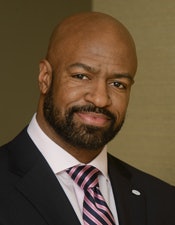
Dental schools are reporting higher enrollments, including more female applicants, according to a study in the Journal of Dental Education. Increased enrollment is attributed to new schools and expanding class sizes at existing schools.
 Bryan Cook, PhD, study co-author and ADEA senior vice president for educational research and analysis.
Bryan Cook, PhD, study co-author and ADEA senior vice president for educational research and analysis.The analysis by the University of Virginia School of Medicine and the American Dental Education Association (ADEA) includes data from all 65 U.S. dental school from the 2013-2014 cycle for enrollees entering in fall 2014 (Journal of Dental Education, November 2015, Vol. 79:11, pp. 1373-1382). In 2014, there were 11,745 dental school applicants who submitted 114,924 applications compared with 12,162 in 2013, the researchers found.
One of the reasons for the growing number of dental students is the profession's appeal, study co-author Bryan Cook, PhD, told DrBicuspid.com. "The most fundamental is that dentistry has a lot to offer," he said. Cook is the ADEA senior vice president for educational research and analysis.
Dentistry is regularly ranked as one of the top jobs overall. "It gives people an opportunity to take care of others," Cook noted. One of most commonly cited reasons for these rankings, including starting salaries of more than $100,000, is work/life balance, he added. "Dentists are generally able to set their own work schedule and rarely have to be on call for emergency care," Cook said.
More schools, more women
While there has been a gradual decline in the number of people taking the dental admission test (13,406 in 2010 compared with 12,923 in 2014), the number of first-year dental students has continuously increased during the five-year period between 2010 and 2015. The number of first-time, first-year enrollees has increased by almost 1,000 since 2010, bringing the total to 5,892 in 2014.
The number of women applying to dental school is increasing, while the number of men doing so has declined in the last four years, according to the study authors. In 2014, 5,925 men applied, the lowest number since 2004, while 5,686 women applied to dental schools. In 2000, 1,504 (19%) more men applied to dental school than women. By 2014, only 239 (2%) more men than women applied.
Overall, in 2014, slightly more men than women enrolled (51.2% compared with 49.6%). However, there were seven schools (not named in study) whose enrollees were more than 60% men and four schools where enrollees were more than 60% women.
"A big driver of the increase in female applicants is a reflection of what is happening in higher education more broadly," Cook said.
According to U.S. Census data, for the first time in 75 years, women are now more likely to have a bachelor’s degree than men, he noted. Additionally, a survey from the Council of Graduate Schools found that female enrollment in graduate school has been increasing for several years to the point that women now comprise over half of all gradate/professional school enrollment.
Few minority applicants
Those who identified as black, Hispanic, American Indian, and Pacific Islanders made up only 14% of applicants and 13% of enrollees in 2014. The number of black applicants fell from 756 in 2009-2010 to 699 in 2013-2014, with 318 black enrollees in 2014. Black students had lower enrollment rates in 2014 (44%) than Hispanic students (52%).
| Applicants & first-time enrollees by race & ethnicity for U.S. dental schools in 2014 | |||||
| Applicants | First-time enrollees | ||||
| Race/Ethnicity | Number | Percent | Number | Percent | Enrollment rate |
| White | 5,910 | 50.3% | 3,166 | 53.7% | 53.6% |
| Asian | 2,891 | 24.6% | 1,376 | 23.4% | 47.6% |
| Hispanic/Latino | 965 | 8.2% | 500 | 8.5% | 51.8% |
| Black | 581 | 4.9% | 256 | 4.3% | 44.1% |
| Pacific Islander | 12 | 0.1% | 3 | 0.1% | 25% |
However, the number of American Indian applicants rose from 101 to 134 over the past five years, and there were 64 American Indian enrollees in 2014, the authors noted.
To increase diversity, Cook said multiple approaches are needed, including more targeted recruitment and outreach efforts to encourage diverse candidates to apply to dental school. "This targeted recruitment involves creating more middle and high school programs that offer both academic and career experiences that will not only expose them to a dental career but also support their dental career preparation," he said.
Most applicants
As in previous years, the schools with the most applicants were New York University College of Dentistry (4,581), Boston University Henry M. Goldman School of Dental Medicine (4,118), and Tufts University School of Dental Medicine in Medford, MA (3,662). New York University and Tufts have the largest student bodies of all U.S. dental schools, with 382 and 110 first-year enrollees, respectively.
GPA, DAT scores
Some 93% of dental schools now use some aspect of a "holistic" admissions process using "experiences, attributes, and academic metrics," the study authors noted. Both grade point averages (GPAs) and the Dental Admissions Test (DAT) scores have increased significantly since 2000 among both applicants and enrollees, and they were at an all-time high during the 2013-2014 enrollment cycle, the researchers found. Very few students were admitted with a science GPA under 3.0.
The findings are consistent with the trends in recent years, Cook said. "We know that there is a growing demand for dental care, and therefore a growing demand for education," he concluded.



















